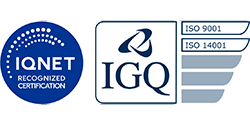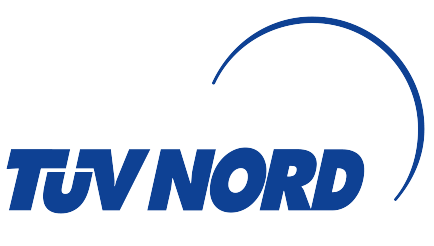
Stainless steels austenitic
Corrosion-resistant, non-magnetic steels
In addition to chromium – a basic element of all stainless steel – austenitic stainless steels also contain high levels of nickel, an element that significantly improves its resistance to corrosion, as well as the possible addition of other elements such as molybdenum, titanium, and niobium, present in some versions.The austenitic structure of these steels does not allow the execution of quenching and tempering treatments, but cold drawing deformations allow very high mechanical characteristics to be obtained, especially on small diameters.
At the solubilized state they are completely non-magnetic, while in the drawn state they acquire a slight ferromagnetism.
The versions with the addition of copper, instead, have a decidedly improved cold deformability, making them suitable for example for use in formed screws and in general for cold forming.
The steels of the Plus series undergo special processing during casting and an analytical balancing that provides them with an excellent machinability in the tool in relation to this category of materials.
The addition of sulfur, finally, allows an easy machinability of the material and makes it suitable for the production of turned parts with challenging machining; in contrast, the resistance to corrosion is slightly decreased.
RANGE Stainless steels austenitic
-
Rodacciai Mark
204Cu
Steel name
X8CrMnCuN17-8-3 1.4597
Austenitic stainless steel.
-
Rodacciai Mark
302
Steel name
X10CrNi18-8 - Nr.1.4310
Chromium-nickel austenitic stainless steel. The rather high carbon content allows high values of mechanical resistance to be achieved through extrusion hardening. Used for springs, antennas, and high resistance pieces.
-
Rodacciai Mark
303PLUS
303Steel name
X8CrNiS18-9 - Nr.1.4305
Chromium-nickel austenitic stainless steel with the addition of sulfur, which improves machinability by chip removal with machine tools, reducing however the resistance to corrosion in aggressive environments. The special “Plus” processing allows performances to be further improved during machining in terms of surface finish, tool life and machine productivity.
-
Rodacciai Mark
GVR
Steel name
X6CrNiCuS18-9-2 - Nr.1.4570
Steel with characteristics similar to 303Plus, but with the addition of copper which, in addition to improving machinability on machine tools, also makes it suitable for certain types of cold deformation.
-
Rodacciai Mark
304
Steel name
X5CrNi18-10 - Nr.1.4301
The reference steel for the chromium-nickel austenitic stainless steel category, it has good resistance to corrosion, cold deformability, and polishability. Its versatility makes it widely used for cutlery, grills, urban fixtures, and appliances, as well as in the automobile industry and in other applications.
-
Rodacciai Mark
304L
304PLUSSteel name
X2CrNi18-9 - Nr.1.4307
Steel with characteristics similar to 304 but with a limited carbon content, which determines a higher resistance to intercrystalline corrosion and improved weldability. The 304Plus version, in addition to a controlled sulfur content, undergoes a special processing during the steelworks process that further improves machinability by chip removal.
-
Rodacciai Mark
321
321SLSteel name
X6CrNiTi18-10 - Nr.1.4541
Steel with characteristics similar to 304; the addition of titanium makes it more stable and further improves its resistance to intercrystalline corrosion.
-
Rodacciai Mark
347
Steel name
X6CrNiNb18-10 - Nr. 1.4550
Steel with characteristics similar to the previous one, in which niobium is the stabilizing element to improve resistance to intercrystalline corrosion.
-
Rodacciai Mark
304ST
Steel name
X2CrNi19-11 - Nr.1.4306
Steel with characteristics similar to 304L, with a balanced analysis specially designed to enhance the cold deformability characteristics. Used for moulded pieces of all types (screws, pins).
-
Rodacciai Mark
304Cu
Steel name
X3CrNiCu18-9-4 - Nr.1.4567
The addition of copper to the base characteristics of 304 significantly increases cold deformability. It is therefore used for fasteners and in general for cold moulded parts when they are complex and have extreme deformations.
-
Rodacciai Mark
316
Steel name
X5CrNiMo17-12-2 - Nr.1.4401
Chromium-nickel-molybdenum austenitic stainless steel: this combination allows it to resist the action of chlorides. It is the typical steel for use in marine environments or in the chemical and food industries.
-
Rodacciai Mark
316L
316PLUSSteel name
X2CrNiMo17-12-2 - Nr.1.4404
Steel with characteristics similar to 316 but with a limited carbon content, which determines a higher resistance to intercrystalline corrosion and improved weldability. The 316Plus version, in addition to a controlled sulfur content, undergoes a special processing during the steelworks process that further improves machinability by chip removal.
-
Rodacciai Mark
316TISL
316TISteel name
X6CrNiMoTi17-12-2 - Nr.1.4571
Steel with characteristics similar to 316; the addition of titanium makes it more stable and further improves its resistance to intercrystalline corrosion.
-
Rodacciai Mark
1.4435
Steel name
X2CrNiMo18-14-3 - Nr.1.4435
This steel is derived from 316L with an increase in the minimum molybdenum and nickel content: it is one of the most resistant steels in marine environments and in general in the presence of chlorides. It is used in critical situations in contact with salt and in the food industry.
-
Rodacciai Mark
RODINOX® PER ROTOLI
RODINOX® PLUS PER BARRESteel name
RODINOX® per rotoli
RODINOX® plus per barreThanks to extensive studies on the characteristics of stainless steels and market needs, Rodacciai has invented and patented Rodinox®℗, a low-nickel austenitic stainless steel wire with mechanical and corrosion resistance characteristics similar to those of 1.4301 (AISI 304), which it can replace in most cases. The austenitic structure is obtained through an opportune balancing of Ni (lower than 304), Mn, Cu, and N (higher than 304) contents; the other elements are similar to 304. In addition to the complete range of drawn wire products used for household goods, appliances, grills, racks, bicycle spokes, clothesline wires, etc., Rodacciai has also developed Rodinox Plus® in bars, with improved machinability by chip removal characteristics.










